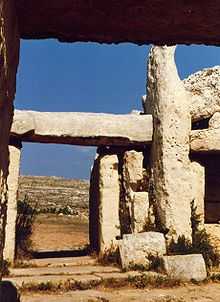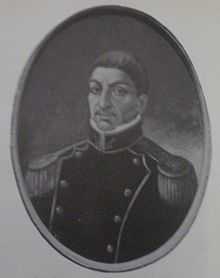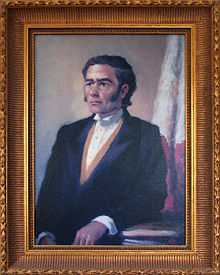Maltese people
| |||||||||||||||||||||
| Total population | |||||||||||||||||||||
|---|---|---|---|---|---|---|---|---|---|---|---|---|---|---|---|---|---|---|---|---|---|
| c. 740,000 | |||||||||||||||||||||
| Regions with significant populations | |||||||||||||||||||||
|
(Maltese descent only) | |||||||||||||||||||||
| 50,039 (2010)[1] | |||||||||||||||||||||
| 43,708 (Maltese-born)[2] | |||||||||||||||||||||
| 40,230 (Maltese-born)[3] | |||||||||||||||||||||
| 38,780[4] | |||||||||||||||||||||
| Languages | |||||||||||||||||||||
| |||||||||||||||||||||
| Religion | |||||||||||||||||||||
| Roman Catholicism[5] | |||||||||||||||||||||
The Maltese (Maltese: Maltin) are an ethnic group indigenous to the Southern European nation of Malta, and identified with the Maltese language. Malta is an island in the middle of the Mediterranean Sea. Included within the ethnic group defined by the Maltese people are the Gozitans (Maltese: Għawdxin) who inhabit Malta's sister island, Gozo.
History
Malta has been inhabited from around 5200 BC, since the arrival of settlers from the island of Sicily.[6] A significant prehistoric Neolithic culture marked by Megalithic structures, which date back to c. 3600 BC, existed on the islands, as evidenced by the temples of Mnajdra, Ggantija and others. The Phoenicians colonized Malta between 800-700 BC, bringing their Semitic language and culture.[7] They used the islands as an outpost from which they expanded sea explorations and trade in the Mediterranean until their successors, the Carthaginians, were ousted by the Romans in 216 BC with the help of the Maltese inhabitants, under whom Malta became a municipium.[8]
After a period of Byzantine rule (4th to 9th century) and a probable sack by the Vandals,[9] the islands were invaded by the Aghlabids in AD 870. The fate of the population after the Arab invasion is unclear but it seems the islands may have been completely depopulated and then later resettled by Muslims who brought with them the Siculo-Arabic language.[10][11]
The Muslim rulers were expelled from the islands by the Normans in 1091, and their leader Roger I of Sicily was welcomed by the native Christians.[8] The islands were part of the Kingdom of Sicily until 1530, and were briefly controlled by the Capetian House of Anjou. In 1530 Charles I of Spain gave the Maltese islands to the Order of Knights of the Hospital of St John of Jerusalem in perpetual lease.
The French under Napoleon took hold of the Maltese islands in 1798, although with the aid of the British the Maltese were able to oust French control two years later. The inhabitants subsequently asked Britain to assume sovereignty over the islands under the conditions laid out in a Declaration of Rights,[12] stating that "his Majesty has no right to cede these Islands to any power...if he chooses to withdraw his protection, and abandon his sovereignty, the right of electing another sovereign, or of the governing of these Islands, belongs to us, the inhabitants and aborigines alone, and without control." As part of the Treaty of Paris (1814) Malta became a British colony, ultimately rejecting an attempted integration with the United Kingdom in 1956.
Malta became independent on 21 September 1964 (Independence Day). Under its 1964 constitution Malta initially retained Queen Elizabeth II as Queen of Malta, with a Governor-General exercising executive authority on her behalf. On 13 December 1974 (Republic Day) it became a republic within the Commonwealth, with the President as head of state. On 31 March 1979 Malta saw the withdrawal of the last British troops and the Royal Navy from Malta. This day is known as Freedom Day and Malta declared itself as a neutral and non-aligned. Malta joined the European Union on 1 May 2004 and joined the Eurozone on 1 January 2008.
Culture
The culture of Malta is a reflection of various cultures that have come into contact with the Maltese Islands throughout the centuries, including neighbouring Mediterranean cultures, and the cultures of the nations that ruled Malta for long periods of time prior to its independence in 1964.

The earliest inhabitants of the Maltese Islands are believed to have crossed over from nearby Sicily sometime before 5000 BC. The culture of modern Malta has been described as a "rich pattern of traditions, beliefs and practices," which is the result of "a long process of adaptation, assimilation and cross fertilization of beliefs and usages drawn from various conflicting sources." It has been subjected to the same complex, historic processes that gave rise to the linguistic and ethnic admixture that defines who the people of Malta and Gozo are today.[13]
Present-day Maltese culture is essentially Latin European with the recent British legacy also in evidence. In the early part of its history Malta was also exposed to Semitic influences. The present-day legacy of this is linguistic rather than cultural. The Latin European element is the major source of Maltese culture because of the virtually continuous cultural impact on Malta over the past eight centuries and the fact that Malta shares the religious beliefs, traditions and ceremonies of its Sicilian and Southern European neighbors.
Language
Maltese people speak the Maltese language, a Semitic language written in the Latin alphabet in its standard form. The language is descended from Siculo-Arabic, a dialect of Arabic spoken in Sicily.[14] In the course of Malta's history, the language has adopted large amounts of vocabulary from Sicilian, Italian, English, and to a smaller degree, French. The official languages of Malta are Maltese and English.
Maltese became an official language of Malta in 1934, replacing Italian and joining English. There are an estimated 371,900 speakers in Malta of the language, with statistics citing that 100% of the people are able to speak Maltese, 88% English, 66% Italian and 17% French, showing a greater degree of linguistic capabilities than most other European countries.[15] In fact multilingualism is a common phenomenon in Malta, with English, Maltese and Italian, used in everyday life. Whilst Maltese is the national language, it has been suggested that with the ascendancy of English language shift may begin;[16] however, this has been discredited by contemporary studies.[17]
Religion
The Constitution of Malta provides for freedom of religion but establishes Roman Catholicism as the state religion.
Malta is described in the Book of Acts (Acts 27:39-42 and Acts 28:1-11) as the place where Paul the Apostle was shipwrecked on his way to Rome, awaiting trial. Freedom House and the World Factbook report that 98% of the Maltese are Roman Catholic, making the nation one of the most Catholic countries in the world.[18]
Maltese emigration and expatriation
In the nineteenth century, most migration from Malta was to North Africa and the Middle East, although rates of return migration to Malta were high.[19] Nonetheless, Maltese communities formed in these regions. By 1900, for example, British consular estimates suggest that there were 15,326 Maltese in Tunisia.[20]
Malta experienced significant emigration as a result of the collapse of a construction boom in 1907 and after World War II, when the birth rate increased significantly, but in the twentieth century most emigrants went to destinations in the New World, particularly the United States and Australia. After World War II, Malta's Emigration Department would assist emigrants with the cost of their travel. Between 1948 and 1967, 30 per cent of the population emigrated.[19] Between 1946 and the late 1970s, over 140,000 people left Malta on the assisted passage scheme, with 57.6 per cent migrating to Australia, 22 per cent to the UK, 13 per cent to Canada and 7 per cent to the United States.[21]
46,998 Maltese-born residents were recorded by the 2001 Australian Census, 30,178 by the 2001 UK Census, 9,525 by the 2001 Canadian Census and 9,080 by the 2000 United States Census.[22]
Emigration dropped dramatically after the mid-1970s and has since ceased to be a social phenomenon of significance. However, since Malta joined the EU in 2004 expatriate communities emerged in a number of European countries particularly in Belgium and Luxembourg.
Genetics
Y-Dna haplogroups are found at the following frequencies in Malta : R1 (35.55% including 32.2% R1b), J (28.90% including 21.10% J2 and 7.8% J1), I (12.20%), E (11.10% including 8.9% E1b1b), F (6.70%), K (4.40%), P (1.10%).[23] Haplogroup R1, I and J2 are typical in European populations and E, K, F haplogroups consist of lineages with differential distribution within Middle East, North Africa and Europe. The study by Capelli et al. has clustered the Maltese genetic markers with those of Sicilians and Calabrians, and has shown that there is little genetic input from North Africa and the Middle East,[24] as evident by the low concentration of E1b1b and J1 (these being respectively typical of North African and Middle Eastern populations [25]).
Population links
The first settlers of Malta were from the island of Sicily.[6] However, the result of the influences on the population after this have been fiercely debated among historians and geneticists. The origins question is complicated by numerous factors, including Malta's turbulent history of invasions and conquests, with long periods of depopulation followed by periods of immigration to Malta and intermarriage with the Maltese by foreigners from the Mediterranean, Western and Southern European countries that ruled Malta.
The many demographic influences on the island include:
- The Phoenician colonisation around 800-700 BC.
- The exile to Malta of the entire male population of the town of Celano (Italy) in 1223
- The stationing of Swabian and Sicilian Italian troops on Malta in 1240
- The removal of all remaining Arabs from Malta in 1224[26]
- The arrival of several thousands Aragonese (Spain) soldiers in 1283 to 1425.
- Further waves of European repopulation throughout the 13th century[27]
- The settlement in Malta of noble families from Sicily (Italy) and Aragon (Spain) between 1372 and 1450
- The arrival of several thousand Greek Rhodian sailors, soldiers and slaves with the Knights of St. John
- The introduction of several thousand Sicilian laborers in 1551 and again in 1566
- The emigration of some 891 Italian exiles to Malta during the Risorgimento in 1849
- The posting of some 22,000 British servicemen in Malta from 1807 to 1979,[28] as well as other British and Irish that settled in Malta over the decades
- The mass emigration occurring after World War II and well into the 1960s and 70s. Many Maltese left the island for the United Kingdom, Australia, Canada and the USA. Following Malta's accession to the EU in 2004 expatriate communities grew in European countries such as the one in Belgium.
Present views
Confirming the idea that the first settlers on Malta were Sicilian, studies on the Y-chromosomes of men, conducted by a collaboration of Mediterranean universities and University College London, have indicated that the Maltese population has Southern Italian origins, with little genetic input from the Eastern Mediterranean and North Africa.[29] However, genetic studies also indicate that the so-called Arabs who colonised Malta during Muslim rule were in fact Arabic-speaking Sicilians — which suggests a native Sicilian Muslim population.[24][30]
Another study carried out by geneticists Spencer Wells and Pierre Zalloua of the American University of Beirut showed that more than 50% of Y-chromosomes from Maltese men could have Phoenician origins.[31] However, it has been noted that this latter study was published as an interview in a popular magazine which is not a peer-reviewed academic journal and its conclusions disagree with the findings of the previously mentioned major peer-reviewed studies.[24]
Historical accounts
Over time, the various rulers of Malta published their own view of the ethnicity of the population.[32] The Knights of Malta promoted the idea of a continuous Roman Catholic presence,[33] and the British colonial rule disregarded a genetic and cultural connection between the Maltese and Italians in an attempt to counteract growing Fascist power in the area.[34]
See also
External links
- Joëlle Pawelczyk, "The Origin of the 'Maltese' Surnames"
- Leah Claire Walz: "Maltese ethnology" (Chapter 3)
References
- ↑ 2010 American Community Survey 1 year estimates
- ↑ Australian 2006 Census
- ↑ http://www.oecd.org/dataoecd/18/23/34792376.xls
- ↑ "Ethnic Origin (264), Single and Multiple Ethnic Origin Responses (3), Generation Status (4), Age Groups (10) and Sex (3) for the Population in Private Households of Canada, Provinces, Territories, Census Metropolitan Areas and Census Agglomerations, 2011 National Household Survey".
- ↑ "Malta". State.gov. 1 January 2004. Retrieved 17 August 2012.
- ↑ 6.0 6.1 "Gozo". IslandofGozo.org. 7 October 2007. Archived from the original on 22 August 2008.
- ↑ Bonanno 2005, p.22
- ↑ 8.0 8.1 Dennis Angelo Castillo (2006). The Maltese Cross A Strategic History of Malta. Greenwood Publishing Group. p. 25. ISBN 978-0-313-32329-4.
- ↑ Victor Paul Borg (2001). Malta and Gozo. Rough Guides. p. 331. ISBN 978-1-85828-680-8.
- ↑ Ibn Hauqal and Tenth-century Malta / A. Luttrell. In: Hyphen: A Journal of Melitensia and the Humanities. / (Malta 1987), pp 157-160
- ↑ The Official Tourism Site for Malta, Gozo and Comino : What to See & Do : Holiday Ideas : Culture and Heritage : Timeline : :Arab Occupation
- ↑ Holland, James (2003). Fortress Malta An Island Under Siege 1940-43. Miramax. ISBN 1-4013-5186-7.
- ↑ J. Cassar Pullicino, "Determining the Semitic Element in Maltese Folklore", in Studies in Maltese Folklore, Malta University Press (1992), p. 68.
- ↑ MED Magazine
- ↑ http://ec.europa.eu/public_opinion/archives/ebs/ebs_243_en.pdf
- ↑ European Commission, "Malta: Country Profile", Euromosaic Study (September 2004). Available online, at http://ec.europa.eu/ Europeans and Language
- ↑ http://ec.europa.eu/public_opinion/archives/ebs/ebs_237.en.pdf
- ↑ "Catholic Church in Malta". GCatholic.org. Retrieved 17 August 2012.
- ↑ 19.0 19.1 Jones, Huw R. (1973). "Modern emigration from Malta". Transactions of the Institute of British Geographers 60: 101–119. JSTOR 621508.
- ↑ Attard, Lawrence E. (1989). The Great Exodus (1918–1939). Malta: Publishers Enterprises Group.
- ↑ King, Russell (1979). "The Maltese migration cycle: An archival survey". Area 11 (3): 245–249. JSTOR 20001477.
- ↑ "Country-of-birth database". Organisation for Economic Co-operation and Development. Retrieved 3 August 2010.
- ↑ (n=90), Population structure in the Mediterranean basin: a Y chromosome perspective, Capelli et al. 2005
- ↑ 24.0 24.1 24.2 A.E. Felice; "The Genetic Origin of Contemporary Maltese," The Sunday Times of Malta,5 August 2007.
- ↑ Levant male genetic lineages, El Sibai et al. 2009
- ↑ Debattista, Martin; Timeline of Malta History; retrieved on [2008-05-14]
- ↑ Constantiae Imperatricis et Reginae Siciliae Diplomata: 1195-1198, ed. T.K.Slzer (Vienna, 1983), 237-240.
- ↑ Joseph M. Brincat, "Language and Demography in Malta: The Social Foundations of the Symbiosis between Semitic and Romance in Standard Maltese," in Malta: A Case Study in International Cross-Currents. Proceedings of the First International Colloquium on the history of the Central Mediterranean held at the University of Malta, 13–17 December 1989. Ed: S. Fiorini and V. Mallia-Milanes (Malta University Publications, Malta Historical Society, and Foundation for International Studies, University of Malta) at 91-110. Last visited 5 August 2007.
- ↑ C. Capelli, N. Redhead, N. Novelletto, L. Terrenato, P. Malaspina, Z. Poulli, G. Lefranc, A. Megarbane, V. Delague, V. Romano, F. Cali, V.F. Pascali, M. Fellous, A.E. Felice, and D.B. Goldstein; "Population Structure in the Mediterranean Basin: A Y Chromosome Perspective," Annals of Human Genetics, 69, 1-20, 2005. Last visited 8 August 2007.
- ↑ C. Capelli, N. Redhead, N. Novelletto, L. Terrenato, P. Malaspina, Z. Poulli, G. Lefranc, A. Megarbane, V. Delague, V. Romano, F. Cali, V.F. Pascali, M. Fellous, A.E. Felice, and D.B. Goldstein; "Population Structure in the Mediterranean Basin: A Y Chromosome Perspective," Annals of Human Genetics, 69, 1-20, 2005. Last visited August 8, 2007.
- ↑ In the Wake of the Phoenicians: DNA study reveals a Phoenician-Maltese link
- ↑ Anthony Luttrell, "Medieval Malta: the Non-written and the Written Evidence", in Malta: A Case Study in International Cross-Currents. Proceedings of the First International Colloquium on the history of the Central Mediterranean held at the University of Malta, 13–17 December 1989. Ed: S. Fiorini and V. Mallia-Milanes (Malta University Publications, Malta Historical Society, and Foundation for International Studies, University of Malta) at 33-45. Last visited 5 August 2007.
- ↑ Anthony T. Luttrell, "Girolamo Manduca and Gian Francesco Abela: Tradition and invention in Maltese Historiography," in Melita Historica, 7 (1977) 2 (105-132). Last visited 5 August 2007.
- ↑ See, e.g.: "Malta: Civil History," in The Catholic Encyclopedia, Volume IX. Published 1910. New York: Robert Appleton Company. Nihil Obstat, 1 October 1910. Remy Lafort, Censor. Imprimatur. +John M. Farley, Archbishop of New York. Last visited 6 August 2007.
Bonanno A. (2005). Malta: Phoenician, Punic and Roman. Midsea Books: Valletta.
| ||||||||||||||||||||||||||||||||||||||||||||
| ||||||||||||||||||||








.jpg)

